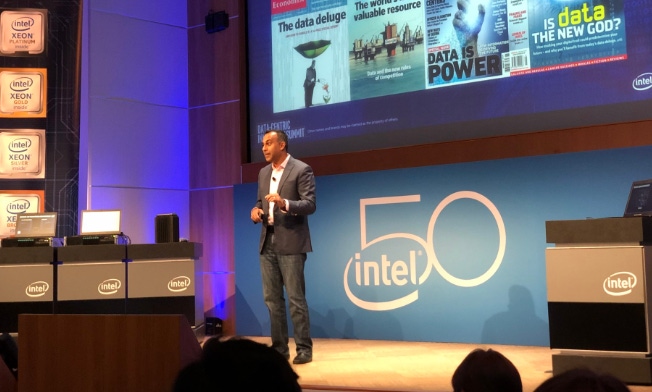The newly emerging artificial intelligence market will be a money-maker, that is no secret, though Intel appears to have taken an early march on the prospering technology.
August 9, 2018

The newly emerging artificial intelligence market will be a money-maker, that is no secret, though Intel appears to have taken an early march on the prospering technology.
The challenge which the technology industry, and all the technology teams in the industrial verticals, are facing is the astronomical amount of data which is flowing around the digital society. To realise revenues associated with the data economy, companies have to make use of this information. That means collecting, storing and processing data with a completely different mindset.
“I find it astounding that 90% of the world’s data was generated in the past two years,” said Navin Shenoy, GM of Intel’s data centre business unit. “And analysts forecast that by 2025 data will exponentially grow by 10 times and reach 163 zettabytes. But we have a long way to go in harnessing the power of this data. A safe guess is that only about 1% of it is utilized, processed and acted upon. Imagine what could happen if we were able to effectively leverage more of this data at scale.”
As with every challenge which is faced by the industry, there is an opportunity to make money. Shenoy believes this challenge is worth more than $200 billion to the data centre industry, the largest prize Intel has ever set its eyes on. Having already claimed $1 billion of this fortune, the team has targeted $10 billion by 2022. And as you can imagine, Intel has developed a new product roadmap to capture the fortunes.
This is of course part of the overall shift in the Intel business as it transitions more towards the data-centric dream. It wasn’t too long ago the data centre business counted for less than a third of total revenues, now it is almost half and continuing to gather momentum. The AI portfolio is receiving a lot of attention now, which will only fuel the shift across to the data-centric dreamland. At Intel’s Data-Centric Innovation Summit, Shenoy provided some much needed depth to the Intel product roadmap.
First and foremost comes the need to move faster in the data centre. Silicon photonics are product a product breakthrough which will help, an innovation which has been incorporated into Xeon processor-based systems, with new products such as SmartNIC set to launch onto the market next year. Speed is of course one aspect, but storage is another. Be prepared for an assault of new products from Intel in this space as the NAND-based products have already been performing very well, while elsewhere, the first Optane DC persistent memory products have been shipped to Google.
The final aspect of the new data-defined era is the need to process everything. This is immensely complicated and requires a huge amount of processing power, but this is the point of the data economy; process seemingly redundant information into useful insight. Last year, Intel unveiled its Xeon Scalable platform, shipping more than 2 million units in 2018’s second quarter, and now it has revealed the next stages of the product roadmap.
Cascade Lake is a future Intel Xeon Scalable processor based on 14nm technology that will introduce Intel Optane DC persistent memory and a set of new AI features called Intel DL Boost. The next, Cooper Lake, will introduce a new generation platform with significant performance improvements, new I/O features, new DL Boost capabilities that improve AI/deep learning training performance, and additional Optane DC persistent memory innovations. Ice Lake is another Xeon Scalable processor based on 10nm technology that shares a common platform with Cooper Lake and is planned as a fast follow-on targeted for 2020 shipments
While all of this might seem incredibly obvious, it is always worth restating the fact. Intel is right in the sense it will require a completely different approach to how data centres and the intelligence business are approached. Before too long, today’s data processing techniques and depth will look very simplistic, though it is not going to be cheap. $200 billion might sound like a wondrous prize for Intel, but customers need to be tempted to sign the cheques. This might be the difference between tomorrow’s winners and losers, those who are prepared to spend big today to get a jump start on the intelligence era.
Intel is a company which has had its fair share of negative press, scandals and share price plummets in recent memory, but arguably there are few organizations who could consider themselves in the same league. In claiming $1 billion of the data-centre prize already, Intel is establishing itself at the forefront of tomorrow’s booming industry. Companies like AMD and Nvidia are racing to catch-up with the market leader, but Intel seems to be sitting very comfortably at the moment.
The price of data storage, transportation and processing is cheaper than ever and still going down. Use cases such as autonomous vehicles and personalised digital experiences are becoming clearer. The opportunity is right in front of use, now it just needs to be made into reality.
Which country will take the leadership position in the 5G world?
China (48%, 71 Votes)
South Korea (19%, 29 Votes)
US (15%, 23 Votes)
Someone else... (10%, 15 Votes)
Japan (7%, 11 Votes)
Total Voters: 149
About the Author(s)
You May Also Like








.png?width=300&auto=webp&quality=80&disable=upscale)


_1.jpg?width=300&auto=webp&quality=80&disable=upscale)


.png?width=800&auto=webp&quality=80&disable=upscale)